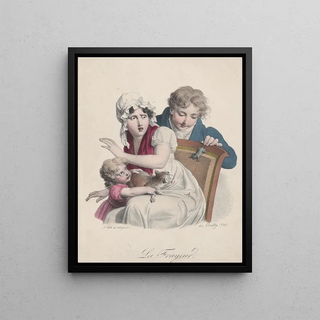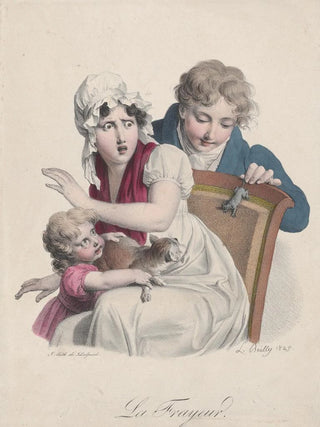Art print | Fear - Louis Léopold Boilly


View from behind

Frame (optional)
Peur - Louis Léopold Boilly – Engaging Introduction
In the vibrant universe of art, some works manage to capture the very essence of human emotions. "Peur" by Louis Léopold Boilly is a perfect example. This canvas, which seems to freeze a moment of palpable tension, invites us to explore the depths of human psychology. Through this piece, Boilly does not merely depict a scene; he immerses us in a universe where fear, with all its complexity, becomes almost tangible. The light, shadows, and expressions of the characters intertwine to create a tableau that still resonates today, prompting us to reflect on our own anxieties and vulnerabilities.
Style and uniqueness of the work
Boilly's style is both precise and evocative. In "Peur," every detail is carefully crafted, demonstrating his technical mastery. The composition is cleverly designed, with the dynamics of the characters immediately drawing the eye. The faces, imbued with intense emotion, are rendered with remarkable finesse. The color palette, though subdued, heightens the drama of the scene, playing on contrasts to emphasize underlying tensions. This artwork is not limited to a simple depiction; it evokes an atmosphere, a sensation, almost a sensory experience. The way Boilly manages to translate anxiety into a visual image is what makes his work so unique and captivating.
The artist and his influence
Louis Léopold Boilly, a French painter of the 18th century, is often recognized for his skill in capturing everyday life of his era. However, his "Peur" art print moves away from usual genre scenes to explore darker and more introspective themes. Boilly established himself as a keen observer of human nature, and his influence is felt in the work of many artists who followed him. His ability to marry realism and emotion paved the way for a deeper exploration of feelings in art. By focusing on intense subjects such as fear, he contributed to enriching the visual language of his time, laying the groundwork for future artistic movements seeking to explore the complexities of the human soul.

Matte finish

View from behind

Frame (optional)
Peur - Louis Léopold Boilly – Engaging Introduction
In the vibrant universe of art, some works manage to capture the very essence of human emotions. "Peur" by Louis Léopold Boilly is a perfect example. This canvas, which seems to freeze a moment of palpable tension, invites us to explore the depths of human psychology. Through this piece, Boilly does not merely depict a scene; he immerses us in a universe where fear, with all its complexity, becomes almost tangible. The light, shadows, and expressions of the characters intertwine to create a tableau that still resonates today, prompting us to reflect on our own anxieties and vulnerabilities.
Style and uniqueness of the work
Boilly's style is both precise and evocative. In "Peur," every detail is carefully crafted, demonstrating his technical mastery. The composition is cleverly designed, with the dynamics of the characters immediately drawing the eye. The faces, imbued with intense emotion, are rendered with remarkable finesse. The color palette, though subdued, heightens the drama of the scene, playing on contrasts to emphasize underlying tensions. This artwork is not limited to a simple depiction; it evokes an atmosphere, a sensation, almost a sensory experience. The way Boilly manages to translate anxiety into a visual image is what makes his work so unique and captivating.
The artist and his influence
Louis Léopold Boilly, a French painter of the 18th century, is often recognized for his skill in capturing everyday life of his era. However, his "Peur" art print moves away from usual genre scenes to explore darker and more introspective themes. Boilly established himself as a keen observer of human nature, and his influence is felt in the work of many artists who followed him. His ability to marry realism and emotion paved the way for a deeper exploration of feelings in art. By focusing on intense subjects such as fear, he contributed to enriching the visual language of his time, laying the groundwork for future artistic movements seeking to explore the complexities of the human soul.






